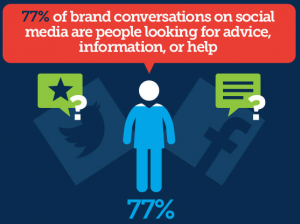Social Media and Market Trends
As we all know from firsthand experience, we like to buy things that are in style. Whether it’s the new seasonal trends or the hot new product everyone is buying, we are more likely to purchase something if other people have it. We clearly saw this in class through our discussion of the Network Effects. Through the Network Effects, we can predict how consumer trends will move based upon the price of a product or service and how many people are using the product. One question arises from this discussion however. If people are basing their decisions on how many other people have the product, where are they getting that information from? In the infographic, Stacey Rudolph examines how social media and advertising play a huge role in convincing consumers that there is a high population of users.
Rudolph claims that social media has made a huge impact on the spread of this information. Never before has it been so easy to see who is buying what. Additionally, companies are able to track these consumer trends via ‘likes’ on Facebook and make marketing decisions accordingly. Because of the high use of social media, companies have begun to use these websites as a huge avenue for marketing products. By creating hype and visibility, they are able to create the illusion of popularity, whether it be true or not.
One interesting snippet from the infographic reports that 77% of brand conversations on social media are people looking for information. This suggests that people like to make their decisions based on other people’s experiences. This may seem obvious but it directly ties to the Network Effects and how people using a product influences others to also procure the product. People naturally want to use what other people are using.
Lastly, these findings also tie back to the unstable equilibrium point found in Network Effects examples. Companies must work hard to market their product so there are enough users to pass this unstable point. After passing it, the effect of other users increases the demand through social media and word of mouth. Once brand loyalty has been established, users will utilize social media to market the product on the company’s behalf increasing demand.
As we can see, social media plays a huge role in consumer behavior and helps us explain the Network Effects in real life.
http://www.business2community.com/infographics/extent-branding-affect-consumers-purchasing-decisions-infographics-01325769

